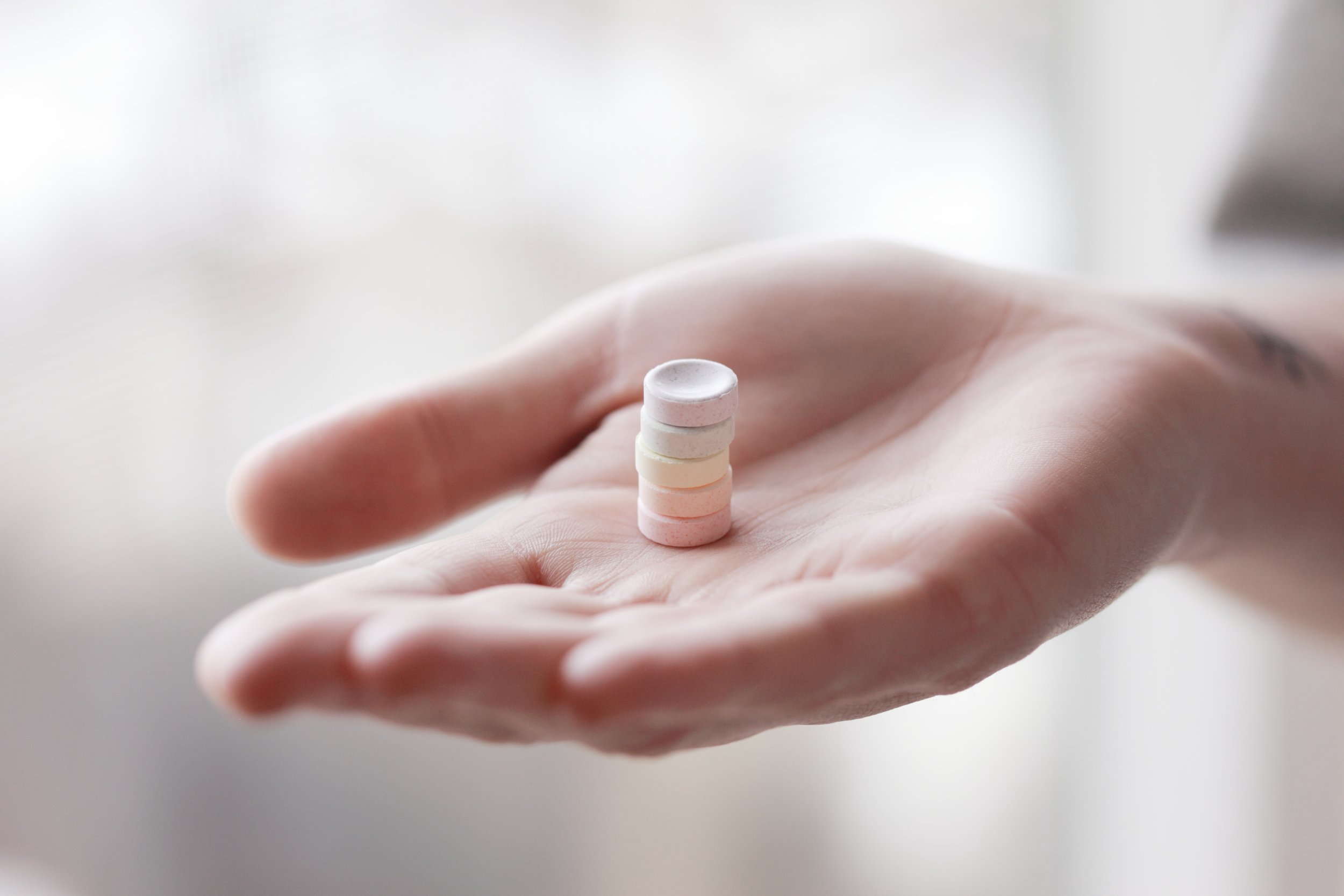June 17, 2019
Vitamin C Questions: Answered
Orthomolecular Medicine News Service, March 27, 2018
Commentary by Helen Saul Case
I was born and raised in a household where we used vitamins instead of medicines. Consequently, I am very familiar with utilizing high-dose vitamin C to prevent and cure illness. Now that I have children of my own, vitamins help keep them healthy, too. I think you can do the same for your family. While I am not a doctor, and you should always work with yours, here are answers to some of the most common questions I have received about vitamin C. Topics addressed include its use in children, during pregnancy and lactation, for the treatment of illness, for the prevention of vaccination side effects, as well as help with vitamin C dosing, form, and frequency.

Photo Credit: Sharon Mccutcheon via Unsplash
VITAMIN C DOSING
How much vitamin C should I take?
Your optimal dose of vitamin C depends on one thing: you. Are you healthy? Stressed? Sick? In sickness it was observed by Robert F. Cathcart, III, MD, that, “The amount of oral ascorbic acid (vitamin C) tolerated by a patient without producing diarrhea (loose bowels) increases somewhat proportionately to the stress or toxicity of his disease” and “[s]tressful conditions of any kind greatly increase utilization of vitamin C.” In other words, the sicker or more stressed you are, the more vitamin C you will “hold” before getting to saturation (bowel tolerance). Bowel tolerance is indicated by gas, a rumbling stomach, or slightly loose stool. If you take way too much C, very loose stool will result, but this goes away once dosages are reduced. When bowel tolerance is reached, this is a sign to back off the extra C. We continue to take C, but we take less and less often. It may take days to resolve illness (it depends how sick we are) but when healthy, the body needs less and “holds” less C.
I take 8,000-10,000 milligrams (mg) of vitamin C orally a day when I am healthy. I take far more when I am under stress. If I am really sick, I may take up to 100,000 mg of vitamin C a day. Two-time Nobel Prize winner Linus Pauling took 18,000 mg of vitamin C a day, and he recommended taking 6,000 to 18,000 mg per day. For healthy children, Frederick R. Klenner, MD, recommended 1,000 mg per day per year of age, leveling off at 10,000 mg per day when the child reaches ten years of age. He recommended far more during illness. For example, in good health, my five-year-old gets 5,000 mg of vitamin C a day and perhaps 25,000 mg per day when sick. We always divide our doses of vitamin C and take it throughout the day. “The effects of this substance (vitamin C) when used in adequate amounts markedly alters the course of many diseases,” said Dr. Cathcart. To read his important paper about bowel tolerance doses of vitamin C as it pertains to specific illnesses see:
“Vitamin C, Titrating to Bowel Tolerance, Anascorbemia, and Acute Induced Scurvy” available at http://www.doctoryourself.com/titration.html.

Photo Credit: Charles Deluvio via Unsplash – Vit C in pommegranate: 10.2mg/100g
I’m confused about vitamin C frequency and dose. Can you help?
I find vitamin C dosing takes some getting used to. If I am sick, stressed, etc., I take vitamin C in divided doses until bowel tolerance (saturation) is reached. Then I continue to take C but less, and less often. So for me, when sick, I may start the day with 8,000 mg and then take 2,000 to 4,000 mg every hour until I experience saturation indicated by a rumbling tummy and/or loose stool. Once saturation is reached, I may still have some symptoms of illness, but they are improved and I feel better. I continue to take saturation level doses of C until I am symptom free, and yes, sometimes it may take a few days depending on how sick I am. When I am healthy, I regularly take 8,000 to 10,000 mg per day in divided doses, approximately 3,000 to 4,000 mg at each meal. (When I am healthy, if I took that 8,000 mg all at once it would be a quick trip to the toilet for sure. But when I’m sick I can “hold” a very large amount of C and can take larger doses.) The optimal amount may differ for other people. For more tips on vitamin C dosing I would check out this helpful article “Vitamin C Material: Where to Start, What to Watch” by Tom Taylor available at http://www.orthomolecular.org/resources/omns/v13n20.shtml. Scroll down to “Quick-Start Procedures for Vitamin C.”
I take 2,000 mg of vitamin C a day. Is that too much?
Animals make between 2,000 and 10,000 mg of ascorbic acid vitamin C a day per human body weight equivalent. Is all of nature wrong? Decades of research have shown incredible benefits can be achieved with high-dose vitamin C. Here is an article that addresses the same question and more: “About ‘Objections’ to Vitamin C Therapy” available at http://orthomolecular.org/resources/omns/v06n24.shtml.
“The number one side effect of vitamins is failure to take enough of them. Vitamins are extraordinarily safe substances.” -Andrew W. Saul

Photo Credit: Lauren Mancke via Unsplash – Vit C in lemon: 53mg/100g
I don’t take much vitamin C but I get to saturation quickly. Why?
You might try reducing or dividing your dose and taking C throughout the day. Also, check your magnesium intake. Magnesium oxide is a common form of magnesium found in supplements. However, due to poor absorption, magnesium oxide is more likely to have a laxative effect which may be confused with saturation of vitamin C. For better absorption, we take magnesium supplements in between meals and in divided doses. In addition to oral supplements (we like magnesium citrate), we also take Epsom salt baths twice a week. Here is more information about magnesium and magnesium safety, including use in children: “Magnesium Decreases Hyperactivity in ADHD Children” available at http://www.orthomolecular.org/resources/omns/v12n20.shtml.
Also see “Magnesium” by Carolyn Dean MD, ND, available at http://www.orthomolecular.org/resources/omns/v13n22.shtml.
Can you get too much sodium from sodium ascorbate vitamin C?
Cardiologist Thomas E. Levy, MD, says that the sodium in sodium ascorbate “does not appear to adversely affect hypertension or increase blood volume.” He writes more about this here:https://www.peakenergy.com/health_ebytes/issue_9.php. Personally speaking, when I or my children are getting a significant amount of sodium as sodium ascorbate we make a point to eat lots of fruits and veggies and drink lots of fresh raw homemade veggie juice (for potassium). We also make a point to get plenty of magnesium via oral supplements and Epsom salt baths. We take ascorbic acid vitamin C with meals, instead of sodium ascorbate.
I read that ascorbic acid is not vitamin C. Is it?
Ascorbic acid is vitamin C. Doctors have been using ascorbic acid and sodium ascorbate vitamin C to cure real diseases for decades. These articles may help:
“Ascorbic Acid Vitamin C: What’s the Real Story?” available at http://www.orthomolecular.org/resources/omns/v09n27.shtml ;
“Vitamin C and Acidity” available at http://www.orthomolecular.org/resources/omns/v05n10.shtml ;
“Vitamin C Has Been Known to Fight 30 Major Diseases … For Over 50 Years” available at http://www.orthomolecular.org/resources/omns/v02n02.shtml ;
and “High-Dose Vitamin C Therapy Proven Effective” available at http://www.orthomolecular.org/resources/omns/v06n01.shtml.
There is much more information about ascorbic acid vitamin C at https://www.seanet.com/~alexs/ascorbate/ andhttp://www.doctoryourself.com.

Photo Credit: Lum3n via Unsplash – Vit C in nectarine: 6.6mg/100g
VITAMIN C THERAPEUTICS
How much vitamin C is needed to treat colds and flu?
According to Robert F. Cathcart, MD, the usual bowel tolerance doses for a mild cold could be somewhere between 30,000 mg to 60,000 mg of vitamin C per day given in divided doses. A person with a severe cold might take 60,000 mg to 100,000 mg per day before reaching bowel tolerance. The flu? Up to 150,000 mg daily might be taken in divided doses to achieve bowel tolerance. And for all those folks who feel great? Taking 4,000 mg to 15,000 mg per day could be enough to get to bowel tolerance. Stress, sickness, infection, vaccinations, postpartum or post-surgical healing, etc., indicates a need for far more. Again, here is a link to Dr. Cathcart’s important paper on bowel tolerance. The entire paper is worth reading. Scroll down to see the dosage chart for vitamin C. Note that the doses on his chart are given in grams and that 1 gram = 1,000 milligrams (mg):
“Vitamin C, Titrating to Bowel Tolerance, Anascorbemia, and Acute Induced Scurvy” http://www.doctoryourself.com/titration.html.
Can vitamin C help skin reactions?
When I have any sort of skin irritation, I take high-dose vitamin C. We give high-dose vitamin C to the kids if they get bitten by mosquitos or stung by bees. Topical vitamin E is also very helpful for healing and soothing irritated skin, including sunburn. For more see: “Vitamins Cure Skin Conditions” http://www.orthomolecular.org/resources/omns/v04n01.shtml.
I have an infection. What can I do?
Whenever “infection” or “-itis” is part of my doctor’s diagnosis, I take saturation level (bowel tolerance) vitamin C until the infection is gone. In high doses, vitamin C works like an antibiotic, antiviral, antihistamine, and antipyretic (fever reducer) without the possible dangerous side effects of pharmaceutical drugs. So, if my doctor hands me a prescription for any of these, I go home and take saturation-level doses of vitamin C instead until my symptoms go away. As my dad Andrew Saul says, “Take enough C to be symptom free whatever the amount may be.” I know I can always go fill the doctor’s prescription, but I am much more comfortable trying a safe, essential vitamin first.
To treat infections, I also take extra vitamin A, make sure I’m getting enough vitamin D (as well as my other vitamins and minerals). I avoid sugar, and I drink lots of fresh, raw homemade veggie juice.
I am not against using antibiotics if they are necessary. However, each year vitamins kill no one: http://www.orthomolecular.org/resources/omns/v13n01.shtml. And for those who cannot take antibiotics at all, they may find they have few other options. If antibiotics are required, so too then are probiotics. Additionally, “Using more vitamin C means needing fewer antibiotics. Using vitamin C along with antibiotics reduces their side effects. Orthomolecular (nutritional) physicians have been reporting this for years.” See: “Antibiotics and Vitamins Work Together” available at http://www.orthomolecular.org/resources/omns/v03n13.shtml.
What we have here are options, and we simply do the best we can for our own health situation. Of course, I am not a physician and it is important to work with your doctor.
Can vitamin C help recovering addicts?
Orthomolecular doctors say yes. Published in the Journal of Orthomolecular Psychiatry 40 years ago, a study by Alfred Libby, MD, and Irwin Stone, PhD, was done “on the use of megadoses of ascorbic acid to detoxify heroin addicts. They compiled 100 case reports of heroin addicts whom they detoxified using ascorbic acid and/or sodium ascorbate in doses of 25-85 g (25,000 to 85,000 milligrams) per day for the first few days, gradually tapering to a holding dose of approximately 10 g (10,000 milligrams) per day. In addition, based on the theory that addicts are malnourished in general and protein deficient in particular, most of these patients were given high levels of multivitamins and minerals and a predigested protein preparation. The patients in this study almost uniformly reported a loss of craving for drugs while taking megascorbate.” To read the entire journal article: “The Use of Ascorbic Acid and Mineral Supplements in the Detoxification of Narcotic Addicts” by Valentine Free, MA, and Pat Sanders, RN, there is a free download at http://www.orthomolecular.org/library/jom/1978/pdf/1978-v07n04-p264.pdf.

Photo Credit: Elaine Casap via Unsplash – Vit C in tomatoes: 13.7mg/100g
VITAMIN C FOR INFANTS, TODDLERS, AND CHILDREN
When did you start giving your children vitamin C, and how much do you give them?
We started supplementing with vitamin C the day they were born. Plus, I took at least 8,000-10,000 milligrams (mg) per day while I was pregnant. Based on Dr. Frederick R. Klenner’s recommendation for infants, we gave our babies oral doses of 50 mg of vitamin C per day. Then we gradually moved up to 1,000 mg per day by age one. However, in the winter, when our kids are sick (or about to be), or when stressed, etc., they get far more vitamin C. It depends on the day; it depends on the kid. We divide the dose and give vitamin C several times throughout the day. When they were really little, they could take pre-made liquid vitamin C by sucking it out of a dropper. Or, we made our own liquid C by dissolving vitamin C crystals in juice. While I was breastfeeding, I took plenty of vitamin C to help ensure that it was available in my breastmilk. We gave them ascorbic acid mixed with buffered calcium ascorbate vitamin C. Now, we like sodium ascorbate (and it is easier on the stomach than ascorbic acid). Practically speaking, we give sodium ascorbate in the morning. Once our kids have food in their bellies, we switch to ascorbic acid or a mix of ascorbic acid and sodium ascorbate. To learn more, here is my article “Tips from a Megavitamin Mom: Getting Kids to Take Vitamins and Lots of Them” available athttp://www.orthomolecular.org/resources/omns/v12n09.shtml. I found this dosing table from Dr. Klenner helpful: A “Therapeutic Level of Vitamin C Supplementation as Employed by F. R. Klenner, M.D.” available athttp://www.doctoryourself.com/klenner_table.html.
How do I give my kids vitamin C without giving them excess sugar to get it down?
I have found that with my kids, making vitamin C tasty gets it down. Lately we have been mixing powdered vitamin C with a little bit of juice. While it is not a sugar free delivery system, for us, the benefits of getting the vitamin C into them outweighs the downside of using a little sweetness to do so. We just see to it that they otherwise have a low sugar diet.
What do you think about liposomal vitamin C? How much should you give children if bowel tolerance can’t be used as an indicator?
“Quality liposomes are generally almost completely absorbed long before the colon is reached,” says Thomas E. Levy, MD. While bowel tolerance is a helpful indicator of “enough” C, a child that looks and feels better is too. We have used liposomal C with success in the past, however currently, my children (and my wallet) prefer vitamin C powder in a little fruit juice. Our protocol with any form of C (as my dad Andrew Saul says) is “take enough C to be symptom free, whatever the amount may be.”
How do you get little kids to take high-dose vitamin C?
We do whatever works. If it gets the C down, we are happy. Keeping it tasty is key. I write about this in detail here: “Tips from a Megavitamin Mom: Getting Kids to Take Vitamins and Lots of Them” available athttp://www.orthomolecular.org/resources/omns/v12n09.shtml.
All the vitamin C chewable tablets I’ve found contain sugar and fillers. What can I do?
Yes, chewables tend to have at least some sugar and flavor so they taste better. Our kids’ chewable vitamin C does too. We just make sure the supplements we give them (and take ourselves) contain no artificial ingredients. It is hard to avoid all fillers, so we do the best we can and we keep in mind that getting the vitamin C into the kids is what is most important. To get around any unwanted ingredients, we buy pure sodium ascorbate vitamin C powder and pure ascorbic acid vitamin C crystals and add the desired dose to about a tablespoon of organic juice. We probably use a dozen different brands of vitamins, and our selection changes as our needs do. We have found chewable tablets to be very handy for packing in their lunch boxes and when travelling.
I can’t find a children’s vitamin C with enough vitamin C in it. What do you give your kids?
When it came to therapeutic dosing of vitamin C, we too had trouble finding children’s supplements that contained more than 250 mg per dose. I bought a prepared (sweetened) liquid children’s vitamin C and then added extra vitamin C powder to it when larger doses were required. When my kids were infants, I used a mixture of ascorbic acid vitamin C and calcium ascorbate vitamin C (buffered vitamin C): about an 80/20 mix respectively and then would administer it with a dropper or, as they got a little older, a medicine spoon. Then we switched to giving them ascorbic acid vitamin C and calcium ascorbate vitamin C in juice. If I were to do it again, I would also use sodium ascorbate vitamin C powder as it is easy on the kids’ tummies and they don’t mind the taste of it.
How can I get my extended family to take vitamins?
The most difficult part for me about knowing that vitamins cure disease is watching others be sick, or turn to dangerous pharmaceuticals, instead of trying nutrition first. I am sure that some people (and doctors) don’t know any better. But even when they do, and they still choose medication over healthy lifestyle changes, I have to remind myself of this quote from Will Rogers: “People’s minds are changed through observation and not through argument.” Nutrition works. It is safe. It is effective. But in my experience, telling others what they should do doesn’t work. They have to come to it on their own.

Photo Credit: the Green Moustache – Vit C in parsley: 133mg/100g
VITAMIN C AND VACCINATION
Can vitamin C prevent side effects from vaccination?
High-dose vitamin C safely prevents and treats vaccine side effects. This has been evident in our experience. We watched high dose, saturation level vitamin C bring our daughter back to health after a severe vaccine reaction. We watched high dose, saturation level vitamin C prevent vaccination side effects. We give both of our children saturation levels of C before, during (yes, right at the doctor’s office) and after immunizations. We don’t give the amount of vitamin C we think might work; we give enough to get the job done.
For more information about vitamin C dosing at vaccination time, here are the articles I wrote about our experience:
“Don’t Vaccinate without Vitamin C” http://www.orthomolecular.org/resources/omns/v11n09.shtml
“Vaccinations, Vitamin C, and “Choice” http://www.orthomolecular.org/resources/omns/v12n07.shtml
This third article, “Vitamin C Prevents Side Effects from the MMR Vaccine,” available at http://www.orthomolecular.org/resources/omns/v12n16.shtml is also about our daughter. However, last summer, our son (age 4) received the first of two required MMR shots. In addition to giving him saturation level, high-dose vitamin C before, during, and after his vaccination, we also followed the advice of pediatrician Ralph K. Campbell, MD, gave him extra vitamin A. In addition to the beta-carotene present in his multivitamin and in the fresh, raw vegetable juice we give the kids each morning, he received 5,000 to 10,000 IU of supplemental preformed fish oil vitamin A the day before and the day of his MMR shot. He, too, did not experience a single side effect due to the MMR vaccine.
Additionally see “Vitamin C Prevents Vaccination Side Effects, Increases Effectiveness” by Thomas E. Levy, MD, available at http://www.orthomolecular.org/resources/omns/v08n07.shtml.
Why did you choose to vaccinate your children?
Philosophical, personal or conscientiously held belief exemptions to vaccinations are not lawful in New York State where our family lives. We comply with state mandated vaccinations, but just the ones required for school, and no more. So yes, we “chose” to have our children vaccinated. Truly, though, we didn’t feel we had much choice.
While we work to mandate vaccine safety, demand informed consent, and advocate for real choice when it comes to whether or not to vaccinate, let’s minimize any chance of vaccine damage now. Children are powerless. We aren’t. Whether we have a choice to vaccinate or not, let’s choose to give them vitamin C and lots of it.
VITAMIN C: WHAT FORM AND WHEN TO TAKE IT
What brand of vitamin C do you recommend?
I don’t endorse or recommend any vitamin brand (nor will I). I can tell you this: I buy vitamins free of artificial sweeteners, artificial colors, and artificial flavors…and I call the company if I have questions about any ingredients or potency. I read and compare lots of labels and choose the best possible (and most affordable) option that gets results. I have used/use vitamin C capsules, tablets, chewables, powder, and liposomal C. As a general rule, if very high doses are required, I use vitamin C powders/crystals mixed in juice. For regular daily doses, I take capsules.
When should I take my vitamins?
I take mine in divided doses throughout the day and with food. My before (or in-between) meal supplements include magnesium and probiotics. I take vitamin C whenever I think of it, with or without food. I take B vitamins together as they work best that way, but I take extra niacin on its own as needed. I take iron separately from vitamin E, and I always take zinc with food to avoid stomach upset.
VITAMIN C: PREGNANCY AND LACTATION
I heard taking too much vitamin C during pregnancy causes infantile rebound scurvy. Is this true?
According to Alan Gaby, MD, infantile “rebound scurvy” is a myth: consuming large quantities of vitamin C during pregnancy does not cause the baby to be born with infantile scurvy. However, why stop a good thing after they are born? Frederick R. Klenner, MD, recommended 50 mg of vitamin C a day starting at birth and 1,000 mg per day per year of age up to age ten for a total dose of up to 10,000 mg per day.
I’m a nursing mom. How much vitamin C should I take?
Your optimal dose really depends on you and your baby. How do you feel? How is baby doing? For example, if mom is under a great deal of stress, less vitamin C will be available for baby in breastmilk. The way I approached it with my kids is this: I was really comfortable taking a lot of vitamin C. While I was breastfeeding, I took (at least) 8,000 to 10,000 milligrams of vitamin C a day in frequent divided doses. We also gave the kids supplemental liquid vitamin C throughout the day in small, but frequent doses, in addition to what they were getting from breastfeeding. As long as they (and I) were happy and healthy, all was good.
Saturation (bowel tolerance) is a very helpful indicator of “too much” vitamin C. Since gassiness comes before loose bowels, it’s a helpful indicator of “enough” vitamin C. If bowel tolerance is reached and stools become frequent, liquid, or, as was the case for my breastfed three-month-old, frequent and greenish in color (since they are always liquid-like), we reduced the frequency and dose, but continued to give C regularly, ramping the frequency and dose up and down as the situation requires. This takes a little practice, but because vitamin C is so safe, we are very comfortable with the process of determining optimal doses for our kids.
Of note, we get the kids to saturation only if needed due to sickness, vaccination, etc. Once they are at saturation, we throttle back the dose. We continue to give C but give less and give it less frequently. We gradually work back to their normal daily dose of 1,000 mg per day per year of age. For much more about vitamin dosing and safety during pregnancy and lactation, you may want to read my book Vitamins & Pregnancy: The Real Story.
(OMNS Assistant Editor Helen Saul Case is the author of The Vitamin Cure for Women’s Health Problems,Vitamins & Pregnancy: The Real Story, and Orthomolecular Nutrition for Everyone.)
If you enjoyed this blog, sign-up for our newsletter to receive future updates.
Nutritional Medicine is Orthomolecular Medicine
Orthomolecular medicine uses safe, effective nutritional therapy to fight illness. For more information: http://www.orthomolecular.org
Find a Doctor
To locate an orthomolecular physician near you: http://orthomolecular.org/resources/omns/v06n09.shtml
The peer-reviewed Orthomolecular Medicine News Service is a non-profit and non-commercial informational resource.
Editorial Review Board:
Ilyès Baghli, M.D. (Algeria)
Ian Brighthope, M.D. (Australia)
Prof. Gilbert Henri Crussol (Spain)
Carolyn Dean, M.D., N.D. (USA)
Damien Downing, M.D. (United Kingdom)
Michael Ellis, M.D. (Australia)
Martin P. Gallagher, M.D., D.C. (USA)
Michael J. Gonzalez, N.M.D., D.Sc., Ph.D. (Puerto Rico)
William B. Grant, Ph.D. (USA)
Tonya S. Heyman, M.D. (USA)
Suzanne Humphries, M.D. (USA)
Ron Hunninghake, M.D. (USA)
Michael Janson, M.D. (USA)
Robert E. Jenkins, D.C. (USA)
Bo H. Jonsson, M.D., Ph.D. (Sweden)
Jeffrey J. Kotulski, D.O. (USA)
Peter H. Lauda, M.D. (Austria)
Thomas Levy, M.D., J.D. (USA)
Homer Lim, M.D. (Philippines)
Stuart Lindsey, Pharm.D. (USA)
Victor A. Marcial-Vega, M.D. (Puerto Rico)
Charles C. Mary, Jr., M.D. (USA)
Mignonne Mary, M.D. (USA)
Jun Matsuyama, M.D., Ph.D. (Japan)
Dave McCarthy, M.D. (USA)
Joseph Mercola, D.O. (USA)
Jorge R. Miranda-Massari, Pharm.D. (Puerto Rico)
Karin Munsterhjelm-Ahumada, M.D. (Finland)
Tahar Naili, M.D. (Algeria)
W. Todd Penberthy, Ph.D. (USA)
Dag Viljen Poleszynski, Ph.D. (Norway)
Jeffrey A. Ruterbusch, D.O. (USA)
Gert E. Schuitemaker, Ph.D. (Netherlands)
Thomas L. Taxman, M.D. (USA)
Jagan Nathan Vamanan, M.D. (India)
Garry Vickar, MD (USA)
Ken Walker, M.D. (Canada)
Atsuo Yanagisawa, M.D., Ph.D. (Japan)
Anne Zauderer, D.C. (USA)
Andrew W. Saul, Ph.D. (USA), Editor-In-Chief
Editor, Japanese Edition: Atsuo Yanagisawa, M.D., Ph.D. (Japan)
Robert G. Smith, Ph.D. (USA), Associate Editor
Helen Saul Case, M.S. (USA), Assistant Editor
Ralph K. Campbell, M.D. (USA), Contributing Editor
Michael S. Stewart, B.Sc.C.S. (USA), Technology Editor
Jason M. Saul, JD (USA), Legal Consultant
Comments and media contact: drsaul@doctoryourself.com OMNS welcomes but is unable to respond to individual reader emails. Reader comments become the property of OMNS and may or may not be used for publication.

Comments